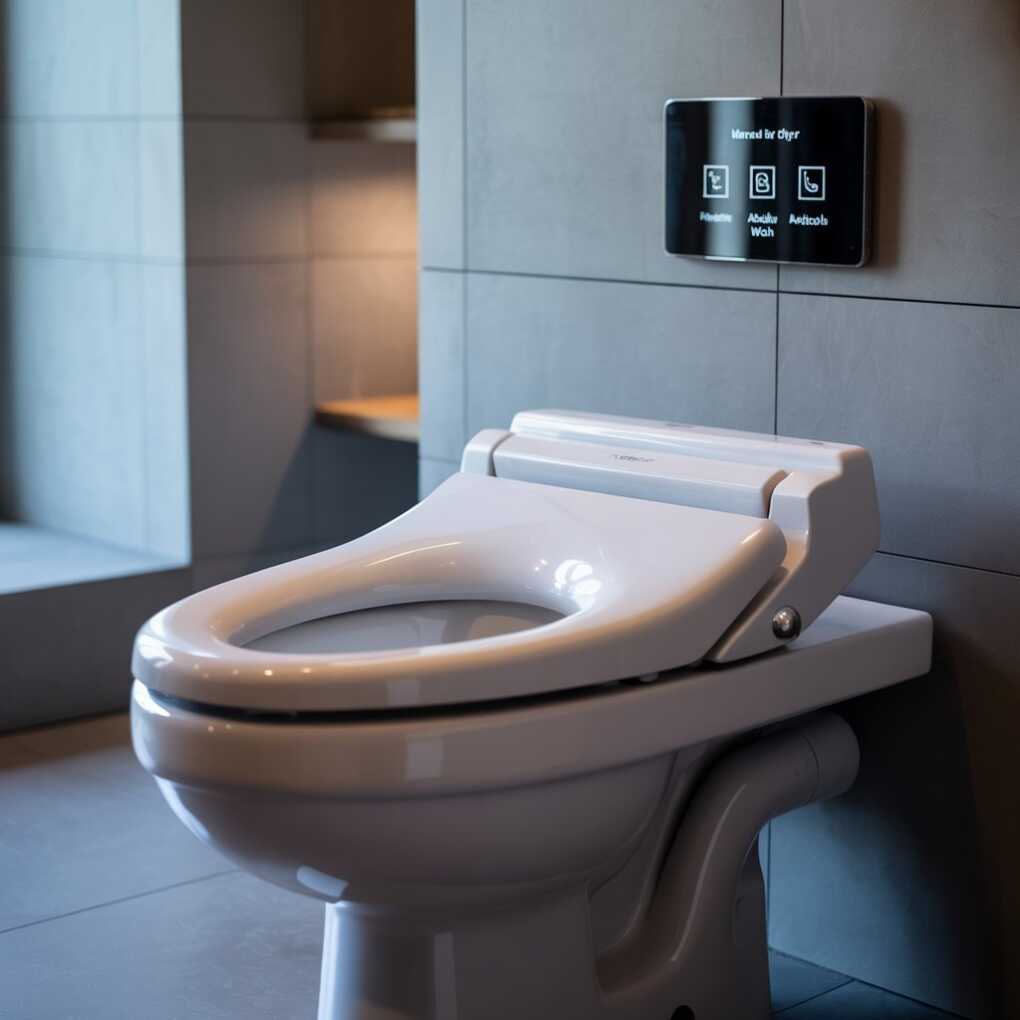In today’s world, bathrooms are no longer just functional spaces—they’re evolving into smart, accessible, and comfortable environments. If you’ve ever struggled with public restrooms or know someone who does, you’ll understand why ADA toilet accessibility is more than just a regulation—it’s a matter of dignity. Enter smart toilets, the technological marvels that are redefining bathroom convenience, hygiene, and accessibility. From automated features to thoughtful design, these innovations are helping people with disabilities enjoy independence and comfort like never before.

Understanding ADA Toilet Standards
Before we dive into the futuristic world of smart toilets, it’s important to understand what an ADA toilet entails. The Americans with Disabilities Act (ADA) sets specific standards for accessible restrooms to ensure inclusivity. But what does that mean in practice?
Key Features of ADA Toilets
An ADA toilet is not just any bathroom fixture—it’s designed with careful consideration for people with mobility challenges. Here are some essential features:
- Height and seat considerations: ADA-compliant toilets are typically 17-19 inches from floor to seat, making it easier for wheelchair users to transfer.
- Grab bars: Strategically placed to provide stability and support.
- Space: A clear floor space of at least 60 inches around the toilet ensures wheelchair maneuverability.
- Flush mechanisms: Easy-to-use handles or sensor-based systems reduce physical effort.
By meeting these standards, ADA toilets aim to create a bathroom that’s safe, functional, and respectful of everyone’s needs. But the magic happens when we pair accessibility with smart technology.
The Rise of Smart Toilets
The bathroom tech revolution is here, and smart toilets are leading the charge. Unlike traditional toilets, smart toilets integrate sensors, automation, and comfort-focused features that were once only seen in luxury homes.
What Makes a Toilet “Smart”?
A smart toilet is equipped with technology that enhances hygiene, comfort, and user experience. Some standout features include:
- Automatic flushing: Say goodbye to awkward handles. Smart toilets can detect when you’ve finished and flush automatically.
- Heated seats: Perfect for chilly mornings and people with mobility issues who spend more time on the seat.
- Bidet functionality: Adjustable water jets for cleaning without strain, which is particularly beneficial for ADA compliance.
- Remote control or voice activation: Ideal for individuals who may struggle with manual controls.
These features don’t just add convenience—they are game-changers for ADA toilet accessibility, making daily routines safer and less physically demanding.
How Smart Toilets Enhance ADA Accessibility
Combining smart technology with ADA compliance creates a bathroom environment that is revolutionary for people with disabilities. Let’s explore exactly how these innovations make a difference.
Reducing Physical Strain
For someone with limited mobility, transferring to and from a toilet can be challenging. Smart toilets reduce this strain through features like:
- Automated lids and seat adjustment: No more awkward bending or reaching.
- Sensor-driven flushing and bidet functions: Users can maintain hygiene without excessive movement.
These thoughtful innovations help preserve independence, which is often overlooked but critical for mental well-being.
Improving Hygiene and Safety
Hygiene is more than a luxury—it’s a necessity, especially for individuals with disabilities. Smart toilets contribute significantly to safety and cleanliness by offering:
- Touchless operation: Minimizes contact with potentially germ-laden surfaces.
- Self-cleaning functions: Some models even clean the bowl automatically after each use, reducing infection risk.
- Anti-slip features: Enhanced design prevents accidents in wet environments, supporting ADA toilet standards.
When safety and cleanliness intersect with technology, the result is a bathroom that genuinely serves everyone.
Personalized Comfort for Every User
One of the best things about smart toilets is personalization. Many models allow users to:
- Adjust water temperature and pressure for bidet functions.
- Program preferred seat temperatures and settings.
- Store multiple user profiles for family or shared spaces.
This customization ensures that ADA toilets are not just accessible—they’re comfortable and user-friendly, removing barriers that were once unavoidable.
Notable Smart Toilet Innovations
The market for smart toilets is booming, and several innovations are particularly noteworthy when it comes to ADA accessibility.
Hands-Free Technology
From automatic lid opening to sensor-based flushing, hands-free systems reduce the need for bending, reaching, or handling. For wheelchair users, this is a monumental improvement. Imagine a toilet that knows you’re ready without a single push—liberating, right?
Advanced Bidet Features
Modern bidets in smart toilets are adjustable for height, angle, and water pressure, which is perfect for ADA-compliant design. Many models also include drying functions, reducing dependence on paper and minimizing strain for people with limited dexterity.
Voice and App Control
Voice-activated toilets or smartphone-controlled settings are no longer science fiction. Users can now:
- Flush or activate bidet functions verbally.
- Adjust seat temperature or lighting without touching any surfaces.
- Receive reminders for cleaning or maintenance.
These innovations make ADA toilets more intuitive and independent, empowering users like never before.
Self-Cleaning and Sterilization
Self-cleaning features are a game-changer for people who may struggle with hygiene tasks. Many smart toilets now include UV sterilization or electrolyzed water systems, keeping surfaces clean with minimal effort.
Safety and Anti-Slip Enhancements
Smart toilets often include built-in safety features such as:
- Non-slip seating surfaces.
- Night lights for low-visibility use.
- Emergency call buttons integrated into the toilet design.
These thoughtful additions align perfectly with ADA toilet standards and improve the overall safety and usability of bathrooms.
Choosing the Right Smart Toilet for ADA Accessibility
Selecting a smart toilet that complements ADA requirements requires careful consideration. Here’s what you should focus on:
Confirm ADA Compliance
Not all smart toilets automatically meet ADA standards. Always check:
- Seat height and transfer space.
- Proper placement of grab bars.
- Ease of use for flush and bidet controls.
Ensuring these details will save frustration and provide the accessibility your users deserve.
Evaluate User Needs
Every user’s needs are unique. Consider:
- Mobility limitations.
- Preference for bidet or hands-free features.
- Sensitivity to water temperature or pressure.
This helps tailor a solution that maximizes comfort and independence.
Budget and Maintenance
Smart toilets are an investment, but their benefits often outweigh costs in terms of independence, hygiene, and comfort. Look for:
- Reliable brands with accessible customer support.
- Easy-to-clean and durable materials.
- Energy-efficient models to reduce operating costs.
Prioritizing quality ensures long-term satisfaction and usability.
Real-Life Impact: Stories from ADA Users
Let’s hear from those who experience the benefits firsthand:
- Sarah, wheelchair user: “The automatic lid and bidet have changed my mornings. I feel independent in ways I never expected.”
- Mark, senior citizen: “I used to worry about slipping at night. The night-light and anti-slip features of my smart toilet give me peace of mind.”
- Family caregiver, Lisa: “It’s a relief knowing my parents can manage hygiene without constant assistance. Smart toilets truly make a difference.”
These personal stories highlight the real-world impact of combining ADA toilets with smart technology—a blend of independence, dignity, and comfort.
The Future of ADA-Compliant Smart Toilets
As technology advances, we can expect even more innovations aimed at improving accessibility. From AI-driven adjustments to predictive hygiene features, the next generation of smart toilets promises even more personalized and intuitive bathroom experiences.
Imagine a toilet that learns your preferences over time, automatically adjusting settings, alerting you to potential maintenance issues, and even integrating with your home’s accessibility systems. The future is bright, and it’s inclusive.
Conclusion
In the end, smart toilets are more than a luxury—they are essential tools in creating inclusive, safe, and comfortable bathrooms for everyone. By combining cutting-edge technology with ADA toilet standards, we are breaking down barriers and enhancing independence for people with disabilities.
If you’re considering upgrading your bathroom or installing an accessible restroom, embracing smart toilet innovations isn’t just smart—it’s transformative. Accessibility, hygiene, safety, and comfort are all achievable with these remarkable innovations, proving that technology and empathy can work hand in hand.
